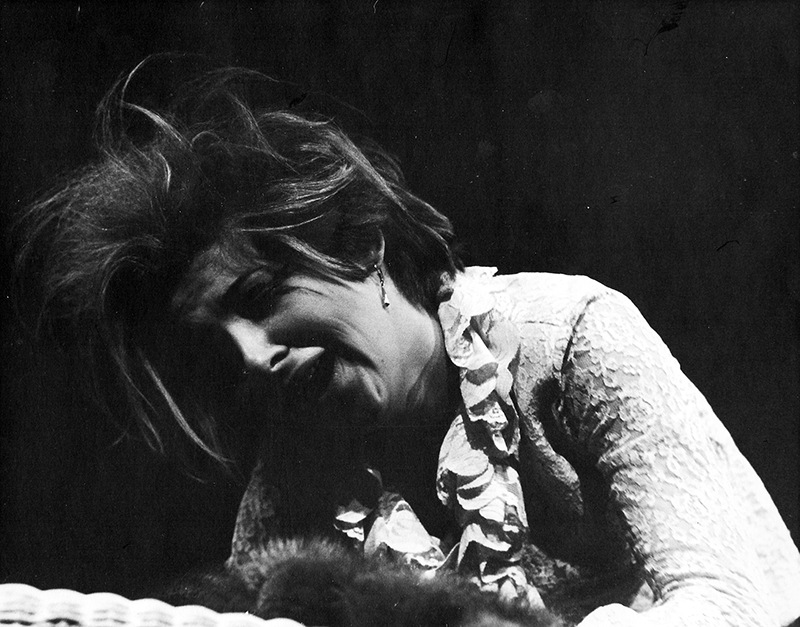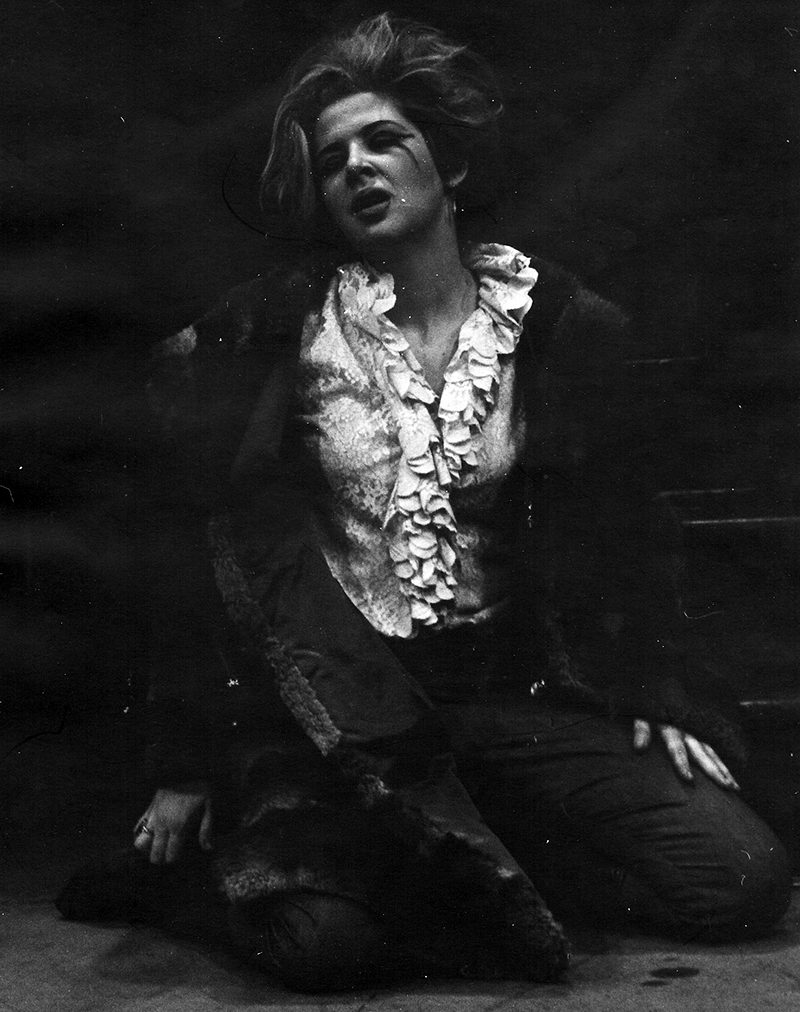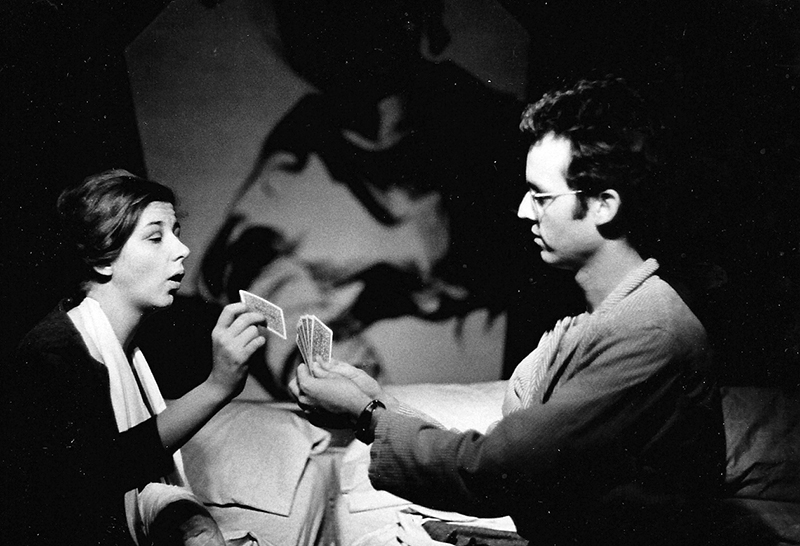Remembering Joan Pape, BA 1965
Distinguished Alumnus Tom Moore remembers his Purdue Theatre colleague and friend Joan Pape as an acting powerhouse who could have earned tremendous acclaim on Broadway

One of my favorite backstage stories that Joan Pape used to tell, always to my and whoever was around’s amusement, was about a time she was doing a perfectly dreadful “avant-garde” play that was, if possible, even more confusing for the audience than for the actors. Whatever it was meant to be had never revealed itself, and playing it for an audience was more painful with each and every performance.
When audience members had the courage to come backstage after the show – and most didn’t – no one ever quite knew what to say. Some were struck mute and could not speak at all.
One night a good friend of Joan’s came backstage and after strained small talk, feeling that she finally had to say something about Joan and the play, started stuttering and stumbling trying to come up with the words. After struggling mightily for a good few minutes, she finally blurted out, “I SAW YOU UP THERE!”
In a theatre crowd, with Joan’s impeccable delivery, that story always “brought down the house.”
At least once a year I would ask her to retell it, and every year I would find myself laughing hysterically as if I had never heard it before.
We’ve all been there. It sort of sums up a life of art in the theatre.

Long before I knew what the phrase “transforming actor” meant, I saw it in action as I first saw Joan perform, when I naively joined the theatre world during my junior year at Purdue University, having realized that perhaps law wasn’t the career for me.
She was quite unforgettable in a whole series of performances that year, once one figured out who she was; but that was difficult because she was never the same. Yes, the hair color seemed to change by the week in those days as she took on one role after another, but it was more than that. Each character was a thing unto itself, and not having a name for it at the time, I found it wondrous, and even sometimes miraculous.
A midwestern girl from Bloomfield, Michigan, Joan was a young theatrical powerhouse – with charisma way beyond her years.
Our time was an extraordinary one for Purdue Theatre – always dependent on who is the pied piper – the leader of the band at the time. For our little band of players, it was Joe Stockdale, an irrepressible dynamo of a theatre director who insisted on professional results from whoever was lucky enough to be in his productions or classes.
No less important were Dorothy Mennen, a noted voice teacher and THE official “encourager” to all at Purdue Theatre; Gene Kildahl, an actor-teacher; Wayne Lamb, choreographer-teacher; and Ross Smith, who corralled all these creative forces into a powerhouse as chair of the department.
Sometimes the stars align, and great talent converges in one place at one time. That impressive troupe of wonderful actors included Cyndi Miller Raff, Bill Lampe, Peter Saputo, Carole Lockwood, Stuart Howard, and, of course, Joan. Friends over a lifetime.
I think Joan and I were only in one play together at Purdue, a rather mediocre “Twelfth Night” in which she played Viola/Orsario, and I gave one of the worst performances ever on a university stage – perhaps any stage – as Feste. It was the beginning of the end of my acting career, but the beginning of a lifelong friendship.
In my senior year, realizing directing was my future, I directed my first play in the Experimental Theatre, Edward Albee’s “The Sandbox.” Fortunately, I instinctually knew that the director’s most vital decision was the casting. I immediately chose Joan. It would be the first of our many, many collaborations over the years.
In time, we became friends, then good friends, and by the time we both graduated and left for the Yale School of Drama, great friends.
When we arrived at Yale, I still didn’t have a name for what kind of an actor Joan was, but I knew she was going to be a YSD star. And indeed she was, from the very beginning.
At Yale, I soon learned how to describe what I had only instinctively known before. Joan was a that rare transformative actor who disappears into each and every role. She was in pretty much every scene and every major project I directed at Yale.
Among the many: Albee’s “Ballad of the Sad Café,” Meghan Terry’s “Ex-Miss Copper Queen on a Set of Pills,” (which we were invited to perform at the Martinique Theatre in New York), and my thesis production, “Funeral March For a One Man Band.” I have often said without exaggeration that I owe at least half of my MFA degree to Joan Pape. O.K. … maybe three-quarters.
Joan was in constant rotation with all the directors in about every theatrical form possible for those three years. But she was in greatest demand for the character parts which few young actors can inhabit, bringing them all off in complete believability. Comedy or tragedy, classical and contemporary – they were all her forte.
When famous theatre critic Robert Brustein became dean and was transforming the school, he also quickly recognized this transformative talent and cast her often with the professionals he started bringing to Yale for mainstage productions – the precursor of the soon-to-be Yale Rep.
One of Joan’s roles was as one of the three Seabirds in the dazzling Jonathan Miller production of Robert Lowell’s adaptation of Aeschylus’ “Prometheus Bound” with Irene Worth and Kenneth Haigh. It was a time of great excitement and possibility at Yale. Professionals from New York were at the school weekly, and the frisson within the student body was palpable.

It is hard to convey just how brilliant Joan was. One reaches for comparison and only the greats come to mind. She was, without hyperbole, the Meryl Streep of our day. Bob Brustein certainly recognized it when he chose her as the first actress from the Drama School to be asked into the professional Yale Repertory Theatre. A unique and singular honor.
She became an annual presence at the Williamstown Theatre Festival and other regional theaters, worked often in New York, and was soon on Broadway as Mae (Sister Woman) in Michael Kahn’s production of “Cat on a Hot Tin Roof” with Elizabeth Ashley. She also played another May in my production of “Once In a Lifetime” with Ed Herman at the Arena Stage in Washington, D.C.
But just as offers were coming in, Joan married, and delivered what turned out to be her most important production, her son Dagan Uhle. Later, as a single mother, she turned all her force and focus to giving him the best life possible.
When Dagan was in college, Joan had finally aged into the roles she was always destined to play. Everyone was encouraging her to re-enter the theatre world, and she was giving it serious thought, when cancer came to visit. Although she and the doctors were able to wrestle it under control, and she would live fully and happily decades more, the cancer left an occasional neurological response that, as she would joke, just like in “Doctor Strangelove,” would cause an arm to suddenly go straight up out of control.
Even though that response occurred infrequently, it was difficult for her to take on a role, knowing that was always a possibility. Such does fate rule our destiny.
So, the world never got to know the exceptional talent of Joan Pape as we, her friends, fellow students, and collaborators did. I think the theatre world is a bit the less for it.
I can’t put it any better than our good friend Gordon Rogoff, professor emeritus at Yale and a major force at YSD during the Brustein years:
“Joan was one of the best at YSD who, in Brando's “Waterfront” words, ‘could have been a contender.’ ‘Should have been’ is more like it. From the first, she reminded me of both Geraldine Page and Kim Stanley, strangely merged and therefore entirely original.”
So yes, Joan, we “SAW YOU UP THERE!” And although in the big scheme of life, it was only for a short time, your performances were indelible for audiences lucky enough to see them, and an inestimable gift for those of us fortunate enough to have created and worked with you.
And as your friend, it was an honor to have shared the journey.
-- Tom Moore BA 1965 (Theatre), HDR 1995